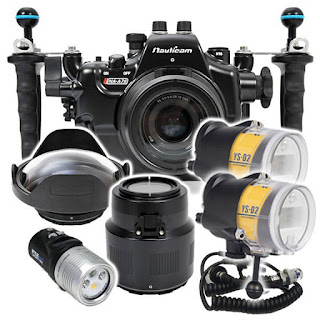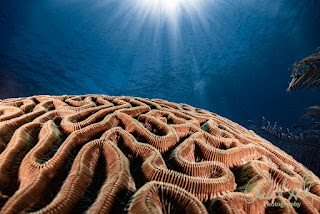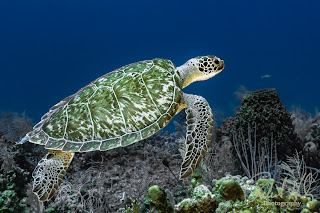A Guide to Understanding Underwater Photography Terminology
Introduction:
Embarking on the mesmerizing journey of underwater photography can be both thrilling and daunting, especially for enthusiasts who are new to the craft. To help you navigate through the sea of technical terms, I've compiled a list of 25 essential lens and camera terms that might leave beginners scratching their heads. Let's dive in and demystify the language of underwater photography!
- Aperture:
- Definition: The aperture is the opening in the camera lens through which light passes. It is measured in f-stops, with lower values (e.g., f/2.8) indicating larger openings and higher values (e.g., f/16) denoting smaller openings. A wider aperture allows more light to reach the camera sensor, making it crucial for low-light underwater conditions.
- Definition: Shutter speed refers to the amount of time the camera's shutter remains open. It is measured in seconds or fractions of a second. Faster shutter speeds (e.g., 1/1000s) freeze fast-moving subjects underwater, while slower speeds (e.g., 1/30s) can create artistic motion blur.
- Definition: ISO determines the camera sensor's sensitivity to light. Higher ISO values (e.g., ISO 1600) are suitable for low-light conditions but may introduce more digital noise. Understanding how to balance ISO with aperture and shutter speed is crucial for achieving well-exposed underwater shots.
- Definition: Depth of field refers to the range of distance in an image that appears acceptably sharp. A shallow depth of field (achieved with a wide aperture) can isolate a subject from the background, while a deep depth of field (achieved with a smaller aperture) keeps more of the scene in focus.
- Definition: Macro photography involves capturing small subjects at close distances. Dedicated macro lenses enable photographers to capture intricate details of underwater critters and tiny organisms.
- Definition: A fisheye lens is an ultra-wide-angle lens that produces a distorted, circular image. It's popular in underwater photography for capturing expansive scenes and creating a sense of immersion.
- Definition: Bokeh refers to the aesthetic quality of the out-of-focus areas in an image. Achieving a pleasing bokeh involves using a wide aperture to create a smooth and creamy background blur, drawing attention to the main subject.
- Definition: Chromatic aberration occurs when colors are distorted, often appearing as fringes of color along high-contrast edges in an image. Quality lenses and post-processing techniques can help minimize this optical imperfection.
- Definition: Lens distortion can result in the warping of straight lines, especially towards the edges of the frame. Underwater photographers should be aware of this phenomenon and correct it during post-processing.
- Definition: White balance adjusts the color temperature of an image to ensure accurate color representation. Underwater environments may have different color temperatures, and setting the white balance correctly is crucial for natural-looking images.
- Definition: Full-frame cameras have larger sensors, providing superior image quality, especially in low-light conditions. Crop sensor cameras have smaller sensors, which can affect the effective focal length of lenses.
- Definition: A strobe is an external flash unit used to illuminate underwater scenes. It helps restore lost colors and add contrast to images taken in low-light conditions or at depth.
- Definition: Sync speed is the fastest shutter speed at which the camera can synchronize with an external flash. Understanding your camera's sync speed is crucial for preventing uneven lighting and dark areas in your images.
- Definition: Manual mode allows photographers to manually control aperture, shutter speed, and ISO settings. This provides maximum creative control over exposure but requires a good understanding of these settings.
- Definition: RAW is an uncompressed file format that retains all the original data captured by the camera's sensor. It provides greater flexibility during post-processing, allowing for adjustments to exposure, white balance, and other parameters without loss of quality.
- Definition: Silhouette photography involves capturing the outline of a subject against a bright background, often the sun or a light source. Underwater silhouettes can create dramatic and artistic images, emphasizing the shape and form of marine life.
- Definition: Manual focus allows photographers to manually adjust the focus of the lens instead of relying on autofocus. Underwater photographers often use manual focus to control focus points precisely, especially in challenging conditions or with macro subjects.
- Definition: Backscatter refers to unwanted specks of light caused by particles (like plankton or debris) in the water reflecting the light from the camera's flash. Positioning the strobe correctly, using diffusers, and post-processing techniques can help minimize backscatter.
- Definition: Hyperfocal distance is the closest distance at which a lens can be focused while keeping objects at infinity acceptably sharp. Understanding hyperfocal distance is crucial for achieving maximum depth of field in wide-angle underwater shots.
- Definition: A wet lens is an additional lens element that can be attached underwater to enhance the camera's capabilities. Wide-angle wet lenses can increase the field of view, while macro wet lenses can enable closer focusing on small subjects.
- Definition: Focus peaking is a feature available on some cameras that highlights in-focus areas in the viewfinder or LCD screen. This aids underwater photographers in achieving precise focus, particularly when using manual focus or capturing macro shots.
- Definition: Ambient light is the natural light present in the underwater environment without the use of artificial light sources. Mastering the balance between ambient light and strobe lighting is crucial for achieving well-exposed and vibrant underwater photographs.
- Definition: A housing is a protective case that encases the camera, allowing it to be used underwater. Housings are designed to withstand water pressure and provide access to camera controls, enabling photographers to operate their cameras seamlessly beneath the surface.
- Definition: A snoot is a device attached to an underwater strobe to control and narrow the direction of the light beam. It is commonly used in macro photography to spotlight specific subjects and create a dramatic effect.
- Definition: Color correction filters are optical filters placed in front of the camera lens to compensate for the color loss caused by the water's absorption of different wavelengths. These filters help restore natural colors in underwater images.
Conclusion:
Armed with a deeper understanding of these lens and camera
terms, you're better equipped to navigate the intricate world of underwater
photography. Remember, practice and experimentation are key to honing your
skills. Embrace the challenges, learn from your experiences, and let the
captivating beauty beneath the waves inspire your creativity. Happy capturing!
I am eagerly anticipating your valuable feedback and suggestions.
Sincerely,
Bob Herb
|
|





Comments
Post a Comment
Please let me know your comments.